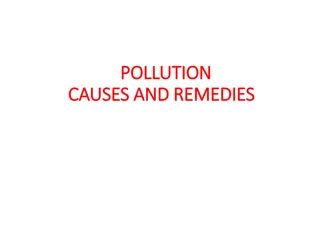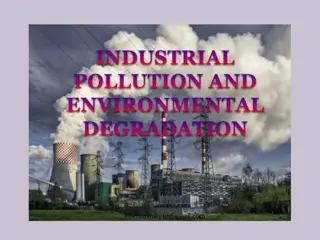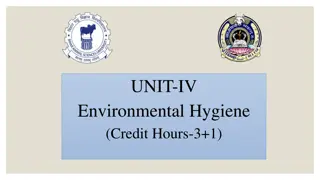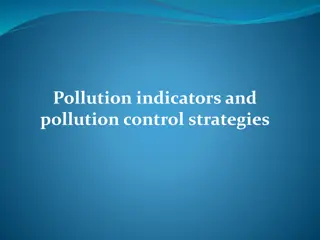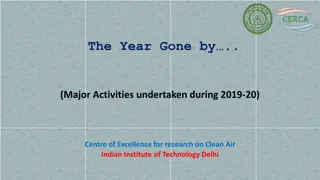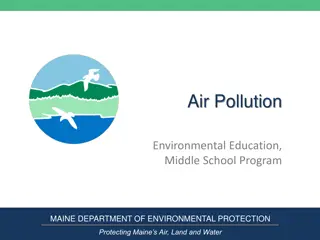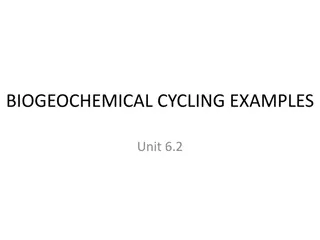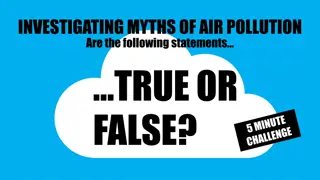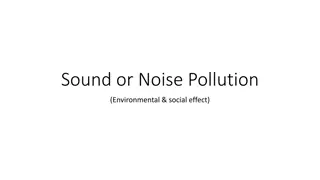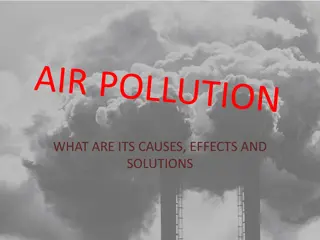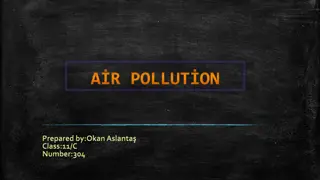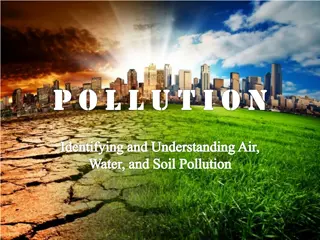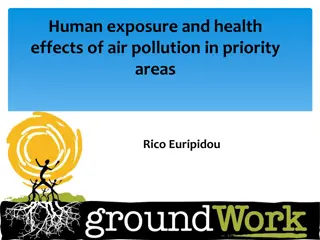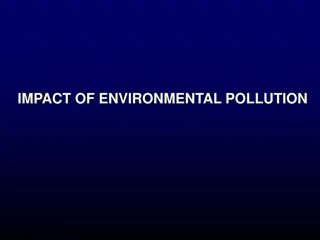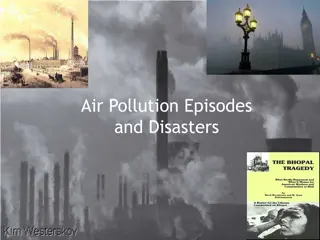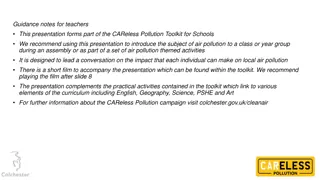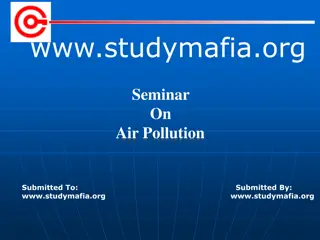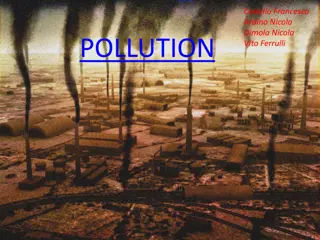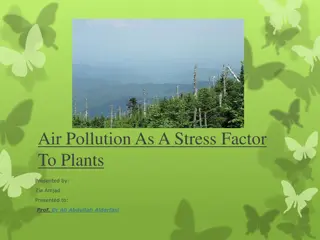Air Pollution Episodes Through History: Causes, Effects, and Regulations
Explore the history of air pollution from the 1930s to 1960s, including key episodes in London, Meuse Valley, and other cities. Learn about the effects of air pollutants, regulatory actions taken, and the evolution of environmental awareness. Discover how industrial activities and population growth contributed to intensified pollution levels, leading to public health concerns and environmental crises.
Download Presentation

Please find below an Image/Link to download the presentation.
The content on the website is provided AS IS for your information and personal use only. It may not be sold, licensed, or shared on other websites without obtaining consent from the author.If you encounter any issues during the download, it is possible that the publisher has removed the file from their server.
You are allowed to download the files provided on this website for personal or commercial use, subject to the condition that they are used lawfully. All files are the property of their respective owners.
The content on the website is provided AS IS for your information and personal use only. It may not be sold, licensed, or shared on other websites without obtaining consent from the author.
E N D
Presentation Transcript
Air Episodes and Sources of Air Pollution By Mohammad ShahidArshad Assistant Professor Civil Engineering Department ACET
Topics History of Air Pollution Air Pollution Episodes Air Pollutants Effects of Air Pollutants
History of Air Pollution 1930 - 1950 s Air Pollution Episodes 1955 First Federal Air Pollution Control Act - funds for research 1960 Motor Vehicle Exhaust Act - funds for research 1963 Clean Air Act Three stage enforcement Funds for state and local agencies
Cont 1965 Motor Vehicle Air Pollution Control Act- Emission regulations for cars to begin in 1968 1967 Air Quality Act Criteria documents Control technique documents 1970 clean Air Act Amendments National Ambient Air Quality Standards New Source Performance Standards
Introduction Population Industrial revaluation. Pollution become more intense as emission from homes and factories increased. It was not noticed that serious health damage might be observed in population exposed to air pollutants emitted from the industrial activity until several air pollution episode had occurred. The disasters may cause deleterious genetic effects in addition to gobal problem. increases rapidly after the
Air Pollution Episodes 1. 1873 London, England 2. 1911 London, England 3. DEC 1930 Meuse Valley, Belgium 4. JAN 1931 Manchester and Salford, England 5. OCT 1948 Donora 6. DEC 1952 London, England 7. OCT 1953 New Orleans, LA 8. NOV 1953 New York, NY 9. JAN 1956 London, England 10.1960 NYC
London, England (1873,74,1911,31,52,56) London is famous for its smoky, dirty skies and pea-soup nights wrapped in heavy fog. During this winter, the fog lasted from November to February. In the week following the worst of it, deaths rose 75%. Key ingredients - calm winds, fog, smoke particles from coal burning 1873 and 74 - 700 deaths 1911- 1150 deaths 1952 - 4000 deaths
Cont On Dec.4 1952 a high temp. inversion as a result of which a white fog blanketed London from 5th dec. to 8 th dec. The subsidence inversion did not allow the pollutants to disperse as a result of which the fog become black. The irratating to the human respiratory system and the people soon developed red eye, burning throat and nagging coughs. smog was intensely
Cont It was said that the fog become so black that white shirt become almost black within 20 min. There will be no movement of air and the visibility was zero.
Cont In Dec 1930, an anticyclone (high pressure area) blanketed Belgium, resulting in fog and temp. inversion in Meuse Valley. In 25 km length, with the hills of 80-120 m high on either side there are many industrial plant. Thermal inversion did not allow the pollutants to disperse and for three days continuously area was under thick cover of smog that contain several pollutants mainly SO2, NO2, SPM, metallic fumes. Mixture of SO2 and NO2 aerosols was believed to be main pollutant responsible for disaster. Due to building up of very high ground level concentration of pollutants in the abnormal weather about 60 died and about 6000 became ill. Symptoms were Cough, irritation of eyes, nose and throat, shortness of breath, nausea and vomiting. Thousands of cattle also died. Elder people already suffering from chronic diseases were the most affected.
Donora, Pennsylvania, USA (1948, October 30-31) In anticyclonic weather condition with no air movement, temp. inversion due to sea breeze conditions, and the winter fog did not allow the air pollutants to disperse for four days. SO2 (0.5-2 ppm) and the particulate matter are to be main pollutants responsible for disaster. Out of 14,000 60% become ill, 10% were severely affected and 20 person died. Symptoms include irritation of eye, nose and headache, vomiting and irritation of respiratory track. Oct. 1948 in donora The black mixture of pollutants concentrated with gas and soot that one can even taste it. 10 year latter affected donora residence were found to have the higher rate of sickness and to die at an early age. was so throat, cough,
OCT 1953 New Orleans, LA It result from more or less permanent high pressure area. Ozone is formed by the photo chemical reaction of oxide N2 and HC NO2 absorb solar energy and break into oxygen atom and nitric acid, and O2 is again combine with the oxygen to form ozone. Temp. inversion increases the concentration of exhaust gases and photochemical smog is formed. The physical difficulties caused by smog are irration of eye, throat etc. Subsidence inversion is responsible for pollution problem in los angle. the air
Bhopal (India) Bhopal gas tragedy was a gas leak incident in considered one of the world's worst day. It occurred on the night of December 2 3 1984 at the Union Carbide India Limited (UCIL) pesticide plant. A leak of methyl isocyanate gas and other chemicals from the plant.
Cont Other factors identified by the inquiry included: use of a more dangerous pesticide manufacturing method, large-scale MIC storage, plant location close to a densely populated area, undersized safety devices, and the dependence on manual operations Plant management deficiencies were also identified lack of skilled operators, reduction of safety management, insufficient maintenance, and inadequate emergency action plans. The initial effects of exposure were coughing, vomiting, severe eye irritation and a feeling of suffocation.
Cont 170,000 people were treated at hospitals and temporary dispensaries. 2,000 buffalo, goats, and other animals were collected and buried. Within a few days, leaves on trees yellowed and fell off. Fishing was prohibited causing further supply shortages.
Cont The acute symptoms were burning in the respiratory tract and eyes, breathlessness, stomach pains and vomiting. The causes of deaths were choking reflexogenic circulatory collapse and pulmonary oedema. The stillbirth rate increased by up to 300% and neonatal mortality rate by 200%. It is estimated 1,00,000 to 2,00,000 people have permanent injuries. Reported symptoms are eye problems, respiratory difficulties, immune and neurological disorders, cardiac failure secondary to lung injury, female reproductive difficulties and birth defects among children born to affected women.
Poza Rica (Mexico) On Nov 24 1950, it was seriously affected by an accident spillage of hydrogen sulphide gas. The situation was complicated by weather inversion associate with the little latter air movement. The effect of gas were those characteristics of H2S inhalation The incident cause the illness of 320 person and 22 died. Symptoms are loss of sense, smell, cough, cough, iratiation, nausea. All people get affected.
Classified as : Primary and secondary Natural and manmade Stationary and mobile
According to origin A primary pollutant is an air pollutant emitted directly from a source. A secondary pollutant is not directly emitted as such, but forms when other pollutants (primary pollutants) react in the atmosphere. Examples of a secondary pollutant include ozone, which is formed when hydrocarbons (HC) and nitrogen oxides (NOx) combine in the presence of sunlight; NO2, which is formed as NO combines with oxygen in the air; Acid rain, which is formed when sulfur dioxide or nitrogen oxides react with water.
Natural and Manmade Natural : Pollen and other aero-allergens Ozone from lighting and Sea salt nuclei ozonosphere Smoke, fly ash and gases from Meteorite dust forest fires Natural Hazes Microorganism Gases and odors from swamps and marshes Fog Volcanic ash and gases Natural radioactivity
Photomicrograph of Mildew Cont http://t2.gstatic.com/images?q=tbn:ANd9GcSE-pl9u_JlEeomZuqmIso9BdYXABn0H6U76c8SELx0dgH73gAYlw Photomicrograph of Red Oak Pollen
Cont Manmade : Automobiles Pesticides Insecticides Electronic appliances Smoke Use of chemical Plastics Particulate matter
Cont http://t1.gstatic.com/images?q=tbn:ANd9GcQS9uINnb8BdbhZpNsQhmJdqaH_D_NJ_yyxFJBD8KaQyXnpnkt4 http://t3.gstatic.com/images?q=tbn:ANd9GcQWMSSTM-nYuvKU21IXXAhAi52orAOqA0DQTVNIRPOy6ZhmuQMa
Cont http://t0.gstatic.com/images?q=tbn:ANd9GcQ4yys0Qr1LSLjD4uAYkbV3klkEjQDhNyND0gWkzrdtbuzXOBwhj-jV9C7n-w http://t3.gstatic.com/images?q=tbn:ANd9GcRYqoG0dUHk7voZyjKSLHZScFDVkc04iKifrm9KFQ5S2pgiV3eJWg
Human Health Effects Exposure to air pollution is associated with numerous effects on human health, including pulmonary, cardiac, vascular, and neurological impairments. The health effects vary greatly from person to person. High-risk groups such as the elderly, infants, pregnant women, and sufferers from chronic heart and lung diseases are more susceptible to air pollution. Children are at greater risk because they are generally more active outdoors and their lungs are still developing.
Cont Exposure to air pollution can cause both acute (short-term) and chronic (long-term) health effects. Acute effects are usually immediate and often reversible when exposure to the pollutant ends. Some acute health effects include eye irritation, headaches, and nausea. Chronic effects are usually not immediate and tend not to be reversible when exposure to the pollutant ends. Some chronic health effects include decreased lung capacity and lung cancer resulting from long-term exposure to toxic air pollutants.
Effects on Human respiratory system Cont Both gaseous and particulate air pollutants can have negative effects on the lungs. Solid particles can settle on the walls of the trachea, bronchi, and bronchioles. Continuous breathing of polluted air can slow the normal cleansing action of the lungs and result in more particles reaching the lower portions of the lung.
Health Effects 1. Acute sickness or death. 2. Insidious or chronic disease, shortening of life or impairment of growth. 3. Alteration of important physiological functions, such as ventilation of the lung transport of oxygen by hemoglobin or various functions of the nervous system. 4. Unpleasant odor, impairment of visibility or other effects sufficient to lead individuals to change residence or place of employment. 5. Air pollution is known to be a causal factor in chronic pulmonary diseases like lung cancer, bronchitis, emphysema, and asthma. 6. Aggravation of existing cardiovascular disease. 7. Eye and respiratory tract irritation, headache, dizziness, visual disorders, and memory impairment are among the immediate symptoms that people have experienced soon after exposure to some organic compounds.
Cont Damage to the lungs from air pollution can inhibit this process and contribute to the occurrence of respiratory diseases such as bronchitis, emphysema, and cancer
Table 1: Sources, Health and Welfare Effects for Criteria Pollutants. Pollutant Description Sources Health Effects Welfare Effects Carbon Monoxide (CO) Colorless, odorless gas Motor vehicle exhaust, indoor sources include kerosene or wood burning stoves. Headaches, reduced mental alertness, heart attack, cardiovascular diseases, impaired fetal development, death. Contribute to the formation of smog. Sulfur Dioxide (SO2) Colorless gas that dissolves in water vapor to form acid, and interact with other gases and particles in the air. Coal-fired power plants, petroleum refineries, manufacture of sulfuric acid and smelting of ores containing sulfur. Eye irritation, wheezing, chest tightness, shortness of breath, lung damage. Contribute to the formation of acid rain, visibility impairment, plant and water damage, aesthetic damage. Nitrogen Dioxide (NO2) Reddish brown, highly reactive gas. Motor vehicles, electric utilities, and other industrial, commercial, and residential sources that burn fuels. Susceptibility to respiratory infections, irritation of the lung and respiratory symptoms (e.g., cough, chest pain, difficulty breathing). Contribute to the formation of smog, acid rain, water quality deterioration, global warming, and visibility impairment. Ozone (O3) Gaseous pollutant when it is formed in the troposphere. Vehicle exhaust and certain other fumes. Formed from other air pollutants in the presence of sunlight. Eye and throat irritation, coughing, respiratory tract problems, asthma, lung damage. Plant and ecosystem damage. Lead (Pb) Metallic element Metal refineries, lead smelters, battery manufacturers, iron and steel producers. Anemia, high blood pressure, brain and kidney damage, neurological disorders, cancer, lowered IQ. Affects animals and plants, affects aquatic ecosystems. Particulate Matter (PM) Very small particles of soot, dust, or other matter, including tiny droplets of liquids. Diesel engines, power plants, industries, windblown dust, wood stoves. Eye irritation, asthma, bronchitis, lung damage, cancer, heavy metal poisoning, cardiovascular effects. Visibility impairment, atmospheric deposition, aesthetic damage.
Pollutants Sources Effects on Vegetables Aldehydes Photochemical reactions The upper portions of Alfalfa etc. will be affected to Narcosis if 250 ppm of aldehydes is present for 2 hrs duration. Ozone (O3) Photochemical reaction of hydrocarbon and nitrogen oxides from fuel combustion, refuse burning, and evaporation from petroleum products. All ages of tobacco leaves, beans, grapes, pine, pumpkins and potato are affected. Fleck, stipple, bleaching, bleached spotting, pigmentation, growth suppression, and early abscission are the effects. Peroxy Acetyl Nitrate (PAN) The sources of PAN are the same as ozone Young spongy cells of plants are affected if 0.01 ppm of PAN is present in the ambient air for more than 6 hrs. Nitrogen dioxide (NO2) High temperature combustion of coal, oil, gas, and gasoline in power plants and internal combustion engines. Irregular, white or brown collapsed lesion on intercostals tissue and near leaf margin. Suppressed growth is observed in many plants. Ammonia & Sulfur dioxide Thermal power plants, oil and petroleum refineries. Bleached spots, bleached areas between veins, bleached margins, chlorosis, growth suppression, early abscission, and reduction in yield and tissue collapse occur. Chlorine (Cl2) Leaks in chlorine storage tanks, hydrochloric acid mists. If 0.10 ppm is present for at least 2 hrs, the epidermis and mesophyll of plants will be affected. Hydrogen fluoride, Silicon tetrafluoride Phosphate rock processing, aluminum industry, and ceramic works and fiberglass manufacturing. Epidermis and mesophyll of grapes, large seed fruits, pines and fluorosis in animals occur if 0.001 ppm of HF is present for 5 weeks. Pesticides & Herbicides Agricultural operations Defoliation, dwarfing, curling, twisting, growth reduction and killing of plants may occur. Particulates Cement industries, thermal power plants, blasting, crushing and processing industries. Affects quality of plants, reduces vigor & hardness and interferences with photosynthesis due to plugging leaf stomata and blocking of light. Mercury (Hg) Processing of mercury containing ores, burning of coal and oil. Greenhouse crops, and floral parts of all vegetations are affected; abscission and growth reduction occur in most of the plants.
Common Air Pollutants US EPA identified Criteria Pollutants based on their health impacts. These are Sulphur Dioxide Nitrogen Oxides, Particulate Matter, Carbon Monoxide and Ozone. In addition VOCs are listed as common air pollutant causing smog. EPA prescribes Primary Standards to protect health and Secondary Standards prevent environmental & property damage.
Effects of Air Pollutants Air Pollutant Impact Sulphur Dioxide Human Health Environment Material Eye Irritation, Respiratory System damage trees & lakes acid aerosols eat stone used in buildings statues, monuments Nitrogen Oxides Lung damage, illnesses of breathing passages and lungs. Pulmonary Edema at very high levels (90 ppm) damage trees & lakes acid aerosols eat stone used in buildings statues, monuments Carbon Monoxide Reduction in oxygen carrying capacity of blood, severe headache, nausea, vomiting, dizziness at high COHb blood levels --- ----
Air Pollutant Impact Human Health Environment Material Sulphur Dioxide Eye Irritation, Respiratory System damage trees & lakes acid aerosols eat stone used in buildings statues, monuments Nitrogen Oxides Lung damage, illnesses of breathing passages and lungs. Pulmonary Edema at very high levels (90 ppm) damage trees & lakes acid aerosols eat stone used in buildings statues, monuments Carbon Monoxide Reduction in oxygen carrying capacity of blood, severe headache, nausea, vomiting, dizziness at high COHb blood levels --- ----
SO2 : Burning of fuel, Industrial Processes Nox : Burning of gasoline, natural gas, coal, oil etc, Vehicle exhaust, Power Stations SPM : Burning of fuel, Vehicle exhaust, Industrial sources, burning of Refuge, re-suspension of dust CO : Burning of gasoline, natural gas, coal, oil etc. Lead : Leaded gasoline, paint, smelters, Manufacturing of Lead storage batteries Ozone: Chemical reaction of pollutants, VOCs and Nox in the presence of heat and sunlight. VOCs: Released from burning fuel (including Natural Gas), solvents, paints, glues. Cars are important source of VOCs


